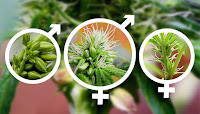Hermaphrodite, as a term for people who have both sex organs, is now considered a slur and is being replaced by the term intersex. No intersex people have both sets of fully functioning sex organs. In that understanding, the old term is both outdated and ignorant.
About 1.7 percent of people are born intersex and about 1 in 2,000 babies are born with genital differences that a doctor might suggest changing with unnecessary surgery. Intersex is an umbrella term for differences in sex traits or reproductive anatomy. Intersex people are born with these differences or develop them in childhood. There are many possible differences in genitalia, hormones, internal anatomy or chromosomes, compared to the usual two ways that human bodies develop. Other animals and cannabis plants form both functioning sex organs, and with pot, “hermies” are often weeded out as undesirable plants. In this issue of The Marijuana Report, we examine new ways to understand intersex pot plants and people as our perception evolves.
Two-Spirit people among Indigenous peoples include males, females and intersex. Special roles were adopted by Two-Spirit people in Native cultures. In the modern LGBTQIA (the I stands for intersex) community, intersex people have been included as their own unique community that, just as with Native peoples, does not mean being trans, gay or queer, per se. Intersex advocates are pushing back on social and medical professionals who tend to steer parents of intersex children toward surgeries when they are young. Many intersex adults who received surgeries report physical and emotional trauma.
interACT, formerly known as Advocates for Informed Choice (AIC), spread awareness of the legal questions surrounding children with intersex traits and advocacy on behalf of these children through various outreach and educational services. Following, we use the messages from one of interACT’s brochures, which can be found on their website: www.interactadvocates.org.
Most marijuana growers panic at any sign of intersex pot plants. Modern growers clone from a female mother plant to guarantee all the plants are female. No male plants are allowed because the pollen from a male plant causes the buds of the female to seed, which lowers the THC potency and decreases the value of the crop. Stress and genetic factors during cultivation can cause a pot plant to produce male and female flowers as the plant matures. Growers carefully inspect their plants for “bananas,” un-blossomed pollen sacks that can form within buds or at nodes on the plant. When the flower opens and releases, it turns yellow.
Pot plants that self-pollinate produce feminized seeds. Many people like feminized seeds because they can grow a batch of plants to maturity directly from seed. Using feminized seeds bypasses the time it takes to fully veg out a female, then cut clones and start the vegetative process all over again. This can save months in the cultivation process.Another reason cannabis breeders like to use the pollen of intersex pot plants is that by inbreeding the strain, certain qualities associated with that plant’s phenotype can be stabilized. First generation cross (also known as F1 cross) breed strains will have a diversity in each seed. More advanced growers tend to like F1 crosses, and the process of selection that comes with them. Seed producers and cannabis genetic companies are paid a premium for feminized seeds. The careful collection of pollen and pollination of intersex plants can put you on the map by distributing those feminized seeds that produce unique effects, as well as a flavor and aroma that can be attached to a new strain name.`
Intersex plants and people are a natural phenomenon. The universe made a third gender for a reason. Parents and cultivators need to see that value and be cautious before destroying the uniqueness of intersex beings and creatures.





